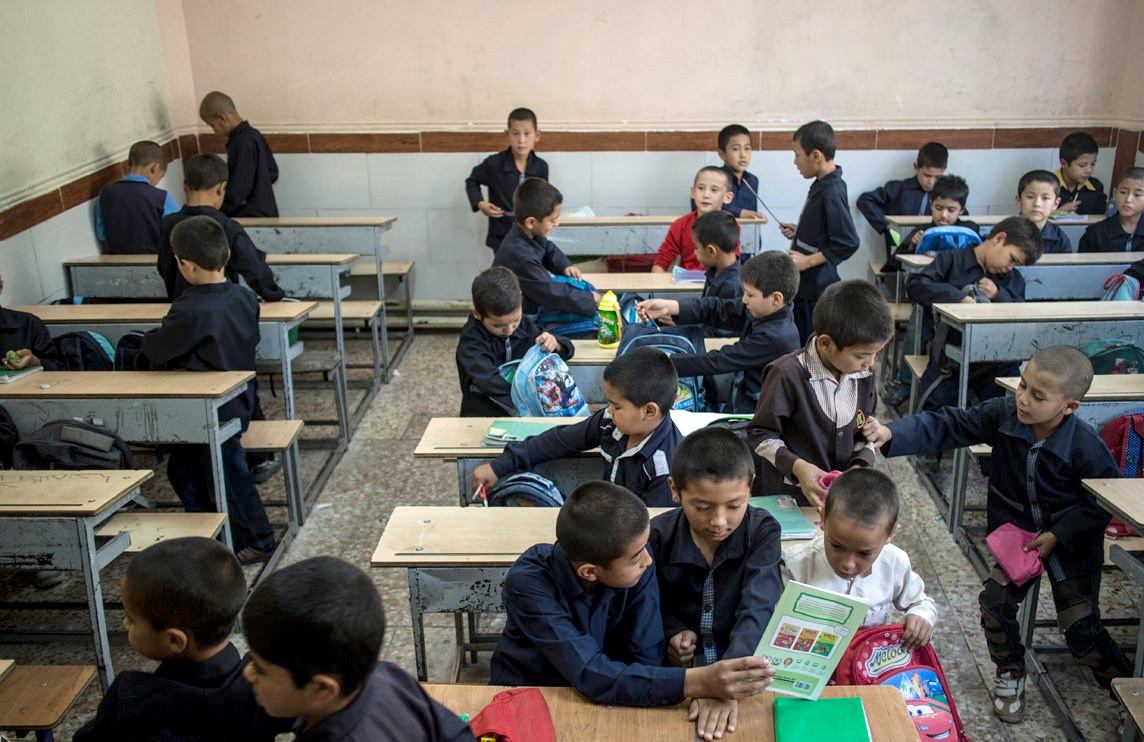Data released by the Tehran-based University of Social Welfare and Rehabilitation Sciences in 2016, shows that 36% of children working in the capital are Afghan nationals.
Education is a crucial component in efforts to eliminate child labor; however as many labor children don’t have birth certificates they are not able to attend school.
Several schools have been established now across Tehran by philanthropists to offer non-formal education and training to labor children. According to the International Labor Organization (ILO), using education in both formal and non-formal settings can play an important role in prevention of child labor and rehabilitation of former child workers.
‘Juyandegan-e Danesh’ with 312 students is one such school which offers non-formal education to Afghan labor children. The 126-sq meter school has been established by an Afghan woman in District 22 (Kan) of the Tehran Municipality.
“Our school with four classrooms and a teachers’ room provides education to hundreds of Afghan children. We offer them skills needed for gainful employment,” Fatemeh Khavari told the Persian language newspaper ‘Iran’.
Around 70% of the students are labor children and most of them do not have birth certificates, a mandatory requirement to be enrolled in formal Iranian schools; some are also unable to pay fees for studying in regular schools, she said.
“Most of the students are not in the grades appropriate to their age as they have remained out of school for several years; however they are still eager to learn; they rush to school every day after they finish their work,” said Khavari, who is also the school principal.
From among seven teachers working in the school, six are Afghan nationals. Around 40 students in different age groups study at the same time in each class. Most of the students are first graders, Khavari said.
“Afghan students are very talented. Many of them have worked since a very young age, and are familiar with math concepts like calculation, money and numbers; that’s why they’re good math learners,” said the only Iranian teacher Mousavi (first name not available) who teaches math although she has studied fine arts in Kabul.
High Dropout Rate
On why she decided to establish the school, Khavari who has lived in Kan District for the last 39 years said, “About 19 years ago, I was given responsibility to collect data on the population and health status of foreign nationals and immigrants, who were mostly Afghans. At that time I realized the number of Afghan children who have dropped out of school is very high because many of them didn’t have residence permits.”
So she decided to educate 20 students in her own home. “After some years 140 more students were sent to me; so I decided to establish a small school for them,” she said.
Several non-formal schools have been established for refugees in Tehran. Last year (ended in March) a new school for Afghan refugee children was opened in Shourabad, Rey County in south Tehran, and 700 children were enrolled. The school was built by an Iranian non-government association Hami (literally, supportive) which is involved in helping refugee children, in cooperation with the United Nations Children’s Fund (UNICEF).
Earlier, Tahereh Pazhuhesh, a member of Hami, said there are two reasons why several Afghan students are still deprived of their basic right to education.
Firstly, many of the children do not have birth certificates and thus there is ambiguity about their age. In the letters of recommendation issued by the Ministry of Interior, their age is not mentioned correctly and therefore many regular schools refuse to register the children on the pretext of not having complete information, she said.
Secondly, a fee of $60 is charged for enrollment and as school uniforms and books are costly, many poor Afghan parents refuse to send their children to school.
Given the hurdles for registration of refugee children in regular schools, establishment of informal schools by NGOs is of great help, Pazhuhesh noted.
“However, efforts should be made to change the culture of Iranian school management and prepare them to accept all children irrespective of nationalities.”
In 2014 the Leader Ayatollah Seyyed Ali Khamenei instructed schools to provide education to all children, even those without legal status.
As of now, 360,693 Afghan children are officially registered in Iranian schools across the 31 provinces and are charged a tuition fee of 1.2-3.6 million rials ($35-$104) according to the educational level.
Tehran, Khorasan Razavi, Isfahan, Qom, Fars, Alborz, and Kerman provinces have the highest number of Afghan students.
Iran continues to host one of the largest and most protracted refugee populations in the world, despite the voluntary return of hundreds of thousands of Afghan refugees to their country over the past decade.
Most Afghans fled to Iran either after the Soviet occupation of Afghanistan in 1979, or following the Afghan civil war in the 1990s and the US-led invasion in 2001. During these decades Iran was home to nearly four million Afghan refugees - the largest refugee population in the world.
UNHCR Assistant High Commissioner George Okoth-Obbo who visited Tehran in April, said there are 960,000 documented Afghan refugees in Iran. T he number of unregistered Afghans is said to be close to three million.


